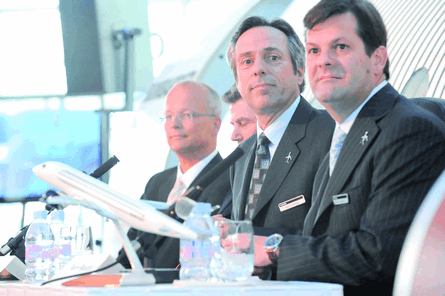Bombardier's decision to finally take the plunge and launch the CSeries created a big splash at the show, but some in the industry were left wondering whether the Canadian manufacturer is swimming in synchrony with its potential airline customers.
Launching the programme on the back of a sole "letter of interest" from Lufthansa raised eyebrows. But the willingness of the German flag carrier's fleet supremo Nico Buchholz to join in the party at Farnborough implies that the firming up of the carrier's commitment for up to 60 aircraft should be a formality.
 |
|---|
| © Billypix |
"We've gone through many details of what could represent a purchase agreement, and once we have finished that, and that shouldn't take too much time, we will sign the definitive agreement," says Buchholz.
On the surface Bombardier seems to have a sound strategy: Airbus and Boeing are holding off pushing the button on replacing their respective A320 and 737 families, while North American carriers are furiously stripping out capacity and could see the smaller, Pratt & Whitney GTF geared turbofan-powered CSeries models as highly attractive alternatives to fuel-guzzlers such as the Boeing MD-80.
But in the run-up to the launch, Bombardier had talked of a requirement for firm orders for 50-100 aircraft, from more than one customer.
"We're very confident that we have enough advanced discussions in place with customers to make this decision," says Bombardier chief executive Pierre Beaudoin.
Commercial aircraft president Gary Scott adds that the manufacturer "continues to talk to many customers", although so far only International Lease Finance and Qatar Airways have expressed interest publicly.
A mischievous John Leahy, Airbus chief operating officer customers, could not resist the opportunity at the show to describe Bombardier's CSeries move as "very courageous. We have never seen a manufacturer launch an aircraft without a firm order. We wish them luck."
Scott says that with the CSeries Bombardier is addressing a sector of the market that Airbus and Boeing "have long ignored". The 50-seats-and-above market could be worth $2.8 trillion over next 20 years, and "there's just a lousy half a trillion or so of that below 150 seats", says a tongue-in-cheek Scott.
"We have an optimised solution for the 100- to 149-seat market. No other airframe manufacturer has that today," he adds.
On possible moves by Embraer, or indeed Airbus and Boeing, to bring new products to the 110- to 150-seat market, Scott says the manufacturer is ready for a fight.
"Our business case assumes very tough competition. We had to prove to ourselves and to our board that we had a product to carry the day, given all the potential moves by competitors. The Embraer 190/195 product line is still relatively young and I'm sure they need to continue with that family for a while. Would they have a larger family downstream? You have to ask them," says Scott.
Embraer executive vice-president airline market Mauro Kern says the Brazilian manufacturer will not be panicked into making "any immediate reaction" to the CSeries, the 110-seat version of which he predicts will be "some 5t heavier than the E-195".
Kern says: "We are working very closely with the three engine manufacturers so that in the mid-term we'll be able to make a structured decision about the next-generation family of airplanes. We will not make any irrational decision by simply reacting to the competitor at this point.
"The CSeries will be in the market by 2013-14 and we will feel that with the E-Jets, and in these hard times we are facing right now, we can offer a very good solution for airlines," he adds.
"In this timeframe - five to six years - the normal improvement chain of the E-190/195 will lead us to an as-competitive or more-competitive product by that time. We have announced a 3% improvement in fuel burn right after programme launch. We'll continue working on this aircraft so we don't see as of today the CSeries as a direct threat."
Having launched the initial CSeries 110 and 130 models, Bombardier says it is in no hurry to look at the possible introduction of larger variants.
"Right now we're focused on building two airplanes and getting two planes into service on time," says Benjamin Boehm, CSeries programme management director.
"We have our hands full. Building a family of airplanes itself is a challenge because you have to be careful that you're not spreading yourself too thin, because then you end up having exactly the same problem that Boeing and Airbus have, where you're building shrinks of shrinks and stretches of stretches. Our focus right now is really a design point that optimises slightly more towards the 110-seat area than the 140-seat area."
The CSeries' PW1524G engine is due to have its first run in the first quarter of 2010 and be certificated by the end of 2011, ahead of the aircraft's first flight in 2012 and entry into service in 2013.
Source: Flight International
















